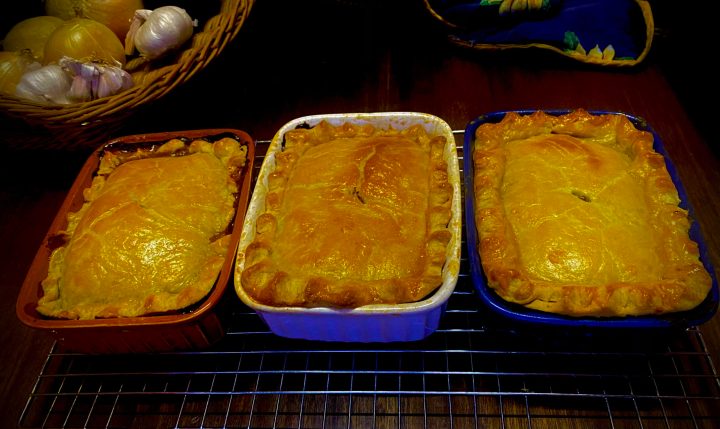TGIFOOD
What’s cooking today: Hot Water Pie Crust

January is tight for many of us, and turning frozen leftovers into pies is an easy and cheap way to transform forgotten leftovers into a family meal. This madly easy pastry topping will work for almost any savoury pie.
That early salary payment many people receive in mid-December is such a boon at the time, but the high CoC (Cost of Christmas) soon puts paid to that heady swirl of indulgence. Come early to mid-January, the next payday seems an aeon away. For those who have a freezer into which leftovers get tucked away in bakkies for a rainy day, now might be the time to see what’s in there and can go into a pie this January.
In our household, it’s often leftover curry that gets frozen for a later day, and curry, if boneless (or if you remove the bones), makes a great pie filling; whether mutton, lamb or chicken. The leftovers of a meaty potjie are also good for a pie, as is leftover roast chicken meat or the meat of any roast joint, whether pork, beef or lamb.
The trick is to revive whatever it is by making a suitable stock or sauce to bring it back to life and ensure that your pie filling is not dry. And to have a recipe to hand for a quick and fuss-free pie crust.
With this in mind this week, I investigated the freezer and found in it the remains of Oom Johan’s rhebuck (ribbok) leg which he brought over the road one day in late winter. I had slow-cooked it in a big pot in vegetable stock with various aromatics, and the leftovers, with a fair bit of said stock, were then frozen. On thawing it I discovered that the meat was just like soft pulled pork and there was so much stock left that it was far from too dry for use in a pie.
However, I took it a stage further, as I had to hand the tougher bits of some other venison from which I decided to make a fresh venison stock. Into a pot went these venison bits, with celery, carrots, onion, leeks, peppercorns, star anise, and juniper berries, which I reduced down to a shadow of its former self.
I added a glass of merlot (which I also happened to have to hand) along with 3 Tbsp of sweet soy sauce (or kecap manis) and salt and pepper. Once this was reduced to a nice syrupy sauce and seasoned with salt and pepper, it was ready for the pie.
The thawed venison meat from the formerly frozen ribbok leg only had to be pulled apart into slivers by hand and kept aside ready to go into a pie.
I poured the new sauce over the shredded venison meat in the pie dish, and put homemade hot water pastry over it, folding it over at the edges and crimping them with my fingers. A quick brushing of egg wash, a hole prodded at the centre with a blunt knife, and the pie was ready for the oven.
So, you can follow this method, more or less, for pretty much any leftovers you might have, and adapting your stock/sauce to fit whatever your meat is. For chicken you might prefer white wine instead of merlot, for pork something a little sweeter; for beef, red wine; for venison perhaps a muscadel, port or sherry. For chicken you might want to replace the juniper berries with fresh herbs such as thyme or rosemary, for beef you might fry up some bacon bits to go in; for lamb, oregano thyme and mint, and of course garlic in everything.
The complete pie needs a 220℃ oven for between 25 and 35 minutes or until golden brown. If you use pastry underneath the filling, prick the base many times with a fork before adding the filling. In my version shown here, there was no pastry underneath.
Whatever your filling is, here’s a recipe for a strong and crunchy pastry with rich colour and pleasing texture. It’s super easy and comes to me from my Cradock friend Lani Lombard, who knows a thing or two about pie crusts.
Hot Water Pie Crust
1 cup/250 ml water
250 g salted butter
4 cups plain flour
Melt the butter and water together in a pot and simmer until all the butter has melted and it reaches boiling point. Put the flour into a bowl, make a well, and pour the hot water into it. Stir quickly with a silicone spatula or wooden spoon, just to combine the liquid and flour. Then mix it with clean hands, while it is hot, to form a nice smooth, pliable dough. It does not need salt. (When the hot water mixes with the flour it will cool quickly so that you won’t burn your hands.)
It’s ready to use or you can cover it with cling film and refrigerate for use later. DM/TGIFood
Our Thank God It’s Food newsletter is sent to subscribers every Friday at 6pm, and published on the TGIFood platform on Daily Maverick. It’s all about great reads on the themes of food and life. Subscribe here.
Send your recipes to [email protected] with a hi-resolution horizontal (landscape) photo.
Thank God It’s Food is sponsored by Pick n Pay.



 Become an Insider
Become an Insider
I’m saving this Pie Crust recipe. Thank you.